Old Brownwood Historical Walk
Starts at Brown County Museum of
History
Welcome to Brownwood! We present this brief
twelve-block walk to introduce you to the historical
section of our community and its rich history.
Just follow the numbers in order as you walk the
trail. The photos of the buildings will help you
locate where you are on the trail.
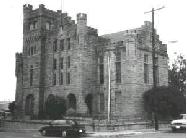 1. Brown
County Museum of History - We start here at the
museum. The museum was organized in 1983 by a
group of citizens of Brownwood to showcase the history
of this area. The old jail became the focal point
of the museum because of its design and availability for
a museum. The Brown County Jail exemplifies the
principles that governed jail design in America in the
late 19th and early 20th Centuries. It was
designed and constructed by two of the leading jail
companies in the South, Youngblood Brothers of Troy,
Alabama, and Martin, Moodie & Company of Comanche,
Texas. This building was built in 1902-1903 as the
3rd county jail. It was completed June 29,1903. It is
made from cut stone in Brown County, which we think was
queried in what is now Lake Brownwood. Al Morton,
a local stonemason, built the stone walls. L. S.
Leversedge & Son of Dallas erected the iron fence. 1. Brown
County Museum of History - We start here at the
museum. The museum was organized in 1983 by a
group of citizens of Brownwood to showcase the history
of this area. The old jail became the focal point
of the museum because of its design and availability for
a museum. The Brown County Jail exemplifies the
principles that governed jail design in America in the
late 19th and early 20th Centuries. It was
designed and constructed by two of the leading jail
companies in the South, Youngblood Brothers of Troy,
Alabama, and Martin, Moodie & Company of Comanche,
Texas. This building was built in 1902-1903 as the
3rd county jail. It was completed June 29,1903. It is
made from cut stone in Brown County, which we think was
queried in what is now Lake Brownwood. Al Morton,
a local stonemason, built the stone walls. L. S.
Leversedge & Son of Dallas erected the iron fence.
In 1981 the county constructed a new jail and work
began to adapt the building as a local museum of
history. After much work of restoring the old jail, the
museum was opened in 1984. The Annex, across the
street, was acquired in 1986.
One of the most famous prisoners was Ray Bourbon, who
was an English actor. He claimed to have acted along
w/Mae West and some others of the era. He had 35 cats,
75 dogs, along with some skunks in his tenure. He
boarded them with Mr. Blount in Big Spring. Upon his
return, he got into an argument with Blount over the
bill, and had him killed. He was brought here for trial
and sentencing. One day, he asked to use the phone, and
when he had completed his call, could not find the
jailer. The front door was open, so he just walked out.
Walking down the street, he happened to remember some
American movies where they turned a prisoner loose in
order to shoot him, so he turned around and walked back
to the jail. Ray died before sentence could be carried
out.
Another escape occurred when two men were put into one
of the side cells where they could reach the bars on the
windows. Apparently, someone smuggled a saw blade
into them. One morning, the milkman asked the sheriff's
wife if she was drying laundry out the second-floor
window. When she went out and looked, it was discovered
that they had cut the bars, used their sheets for rope,
and escaped. Another escape occurred when a
prisoner locked a jailer and a trustee in a cell and
fled the premises.
County Courthouse
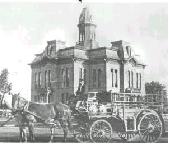 2. From the corner of the
museum, look over toward the county courthouse. In
the early days of Brownwood, most of the business
section of town was built around the square. 2. From the corner of the
museum, look over toward the county courthouse. In
the early days of Brownwood, most of the business
section of town was built around the square.
The first courthouse for the county was a log cabin
about 1-1/2 miles east of its present site. The
courthouse was moved because they were unable to find a
decent well, because of salt water, to provide adequate
water. In 1865 a second story was added to a
building that was to serve as a Masonic Lodge.
When title to the land proved defective, the courthouse
was moved to its current location where a courthouse was
built. This courthouse burned in 1880, and the
county had to move into temporary quarters over on what
is now Fisk Street. There was no courthouse from
1880 to 1885, just a vacant square.
A new courthouse was built in 1884 on the same site as
the one that burned, with the cornerstone being laid on
October 30, 1884. It was French Second Empire
Style, similar to the courthouses that are now in
Weatherford, Lampasas and Hillsboro. That is,
however, not the courthouse you see here today. In
1916, the county decided to repair or remodel the
courthouse, and in so doing, the courthouse was so
thoroughly torn down and repaired that only the vault
and a few walls from the 1884 courthouse survived.
The remodeling was completed in 1917. The
courthouse of today is known as "classical revival
brick".
If you go into the present Justice of Peace office, you
will find the outside wall of the old courthouse, as the
inside wall of his office. It curves back at an
angle to the outside wall.
North Broadway
3. Cross the street, staying on the same side of
the street as the museum, going east. A land
surveyor report that in 1874 there was a hotel by the
name of "The Son Hotel" located on this North side of
the square. It consisted of a room on the north
side and a room on the south side, with a passageway
located between the two rooms. The passageway had
a lean-to in which the cooking and dining room were
located. There were two beds in each room and
pallets for the floor. The hotel was built of logs
and was operated for many years by W. F. & Rhoda
Son.
On this corner, directly across the street from the
jail, where you are now standing, was the Knight Hotel
built in 1885. It was a three-story building with
a basement. This building changed owners and names
many times. It became the Exchange Hotel in 1898,
the Commercial Hotel in 1904 and the Broadway Hotel in
1909.
About 1923, the building was added on to by Dr. Jewel
Daugherty and became the Central Texas Hospital.
The first floor was built of stone walls with the upper
two floors being mason walls. It had about thirty
beds. It offered a nurse-training course, which
was authorized to issue Registered Nurse
certificates. The hospital finally closed in
1938. It was reopened during the heydays of Camp
Bowie, during World War II, and became the Hotel Central
in 1941. When the war was over, the building was
torn down and the Ball & Ball Motor Company built
the present building in 1949. It has had several
owners and business since then with Technakill
Elimination Service being the present tenant.
Next door to the hotel there use to be "The Golden Rule
Saloon" run by a man named Seay. There was a
blacksmith shop next to it.
 4. Continue walking down
the street until you come to the next corner. See
that house on the other side of the street, on the NE
corner of N. Broadway and N. Fisk? 4. Continue walking down
the street until you come to the next corner. See
that house on the other side of the street, on the NE
corner of N. Broadway and N. Fisk?
There has always been a home there since 1898. It
was the Hall home, owned by Tom Hall. About 1918,
the present home was built there and is still occupied.
This second home was built of brick but the owners were
not fond of the brick so they added rock to the
outside. The house is made of concrete with very
thick walls and ceilings. It originally had
gaslights, which were later replaced by
electricity. Each bedroom had its own door to the
outside so people could come and go as they
pleased. Eddie Watson lived in the home and lived
there from 1970 until 2002.
East Broadway
5. Cross the street and turn right, going south
on what is now a parking lot for the county
courthouse. This area use to be Tom Hall's Livery
Stable, with Lathem's Bakery located next door.
6. Continue down the parking lot side of the
street until you come to the flag pole and little park
at the South end of the street. M. V. Coleman, a
grocer was located here at this end of the block and
later, it became the location for Looney
Mercantile. The Looney store was completed in 1920
and was in business here until 1942. In the early
days of the store, it carried a full line of groceries,
hardware, agricultural implements and dry goods.
This area is now known as "Rotary Square," a mini-park
built by the Brownwood Rotary Club in late 1976 as a
project in honor of the American Bicentennial.
In 1947, the name of East Broadway was changed to
North Fisk to match Fisk Street to the South of
here. Fisk Street was named after Greenleaf Fisk,
because he donated sixty acres to the town and one
hundred acres to the county for a courthouse and civic
center. He died in 1888, at the age of eighty-one,
and is buried in the Greenleaf Cemetary, named for him
because he donated the land.
South Broadway
 7. Now look across the
street toward the South side of the courthouse. On the
corner was Happy Jack's Saloon in the late 1800's.
Later, the Corner Drug was located there. It is
now the offices of Charlie V. Gamblin,
Attorney. In the 1880's the White Elephant
Saloon was next door, with its sign, a white elephant on
a pole, out in front. Next door to this saloon was
Hodges and McCord, a general mercantile store, followed
by another saloon known as the "OO Saloon." Other
businesses included J. M. Summers, a clothing and
grocery store, a Drug store, Ramey, Smith & Company,
which was another clothing and grocery store, then a
fruit and confectionery called "The Hole In The Wall,"
operated by Jim Smith. The corner store was
occupied by the Looney Dry Goods and
Grocery. J. C. Weakley, of
Weakley-Watson Hardware Store, had his first hardware
store in the same block, at 209 S. Broadway, earlier in
1876. 7. Now look across the
street toward the South side of the courthouse. On the
corner was Happy Jack's Saloon in the late 1800's.
Later, the Corner Drug was located there. It is
now the offices of Charlie V. Gamblin,
Attorney. In the 1880's the White Elephant
Saloon was next door, with its sign, a white elephant on
a pole, out in front. Next door to this saloon was
Hodges and McCord, a general mercantile store, followed
by another saloon known as the "OO Saloon." Other
businesses included J. M. Summers, a clothing and
grocery store, a Drug store, Ramey, Smith & Company,
which was another clothing and grocery store, then a
fruit and confectionery called "The Hole In The Wall,"
operated by Jim Smith. The corner store was
occupied by the Looney Dry Goods and
Grocery. J. C. Weakley, of
Weakley-Watson Hardware Store, had his first hardware
store in the same block, at 209 S. Broadway, earlier in
1876.
400 Block N. Fisk
8. Now let's cross the street at the light and
continue South to the 400 block of N. Fisk. Stay
on this side of the street. This East side of this
entire block use to be the Wash Hall's Livery Stable,
which was the biggest in West Texas. They employed
five men and met all the trains in town. It had
barns all the way past Pecan Street to the banks of
Adams Branch. Wash Hall bought an open bus-type
conveyance that he rented out to local people with a
driver for the horses. The conveyance became known
as "The Booze Wagon" because the first group that rented
it got roaring drunk. Businessmen used the rented
wagon for trips to nearby towns, and families rented it
out for picnics.
The first telephone line in Brown County ran from
Hall's Livery Stable to the city water pump station
which was located on the stream nearby. The phone
was used to know when to increase the water pressure in
case of fire. One time the pump master raised the
pressure so high it buckled the pipes in the
street. By 1896, there were six phones in
town.

The Empire Furniture Company built a building on this Hall
Livery Stable site in about 1904 and was in business
through the early 30's. Their business covered this
entire block.
300 Block N. Fisk
9. Now, let's continue down the street to the 300
block of N. Fisk, still staying on the East side of the
street to 308 N. Fisk. At this location was the
Wells Fargo's office, which also housed the telegraph,
and on the second floor, the IOOF Hall (Odd Fellows) was
here about 1913. This also became Cheapskate
Chandler's in the 1950's. Ova S. Chandler, who
lived upstairs, had to have a wall taken out to get a
grand piano into her home.
10. Next to this building use to be Marguart's
Blacksmith Shop in 1884 and later became Marguart's
Garage by 1921.
11. Behind this building, on Pecan Street, was
the old jail built in 1876 at the corner of North Pecan
and Water Streets. That building and the
courthouse were torn down after they burned in 1880 and
all the county records were destroyed.
Another jail was built in 1881, but by 1901, the jail
was recognized as being insufficient for the county's
needs. So the jail where the museum is now located
was constructed in 1903.
12. A building at 301 N. Fisk was built by J. C.
Weakley back in 1880. This building has since been
torn down by 1909. He first rented it out to the
courthouse when the old courthouse burned back in
1880. Nelse Allman remembered that court was held
upstairs in the building at this location prior to the
present courthouse being constructed.
13. The building still standing at 303 N. Fisk
was constructed in 1909 and opened as Charles Haynie
Groceries. The grocery store was still in business
in 1913 but by 1921 it was W. C. Furniture
Company. They have a photo of the building hanging
in the hallway that was taken in 1909.
Continue walking down the street to the corner and
cross the street.
Mayes Street off N. Fisk
14. Looking west on East Street, you will see the
little triangle shape building that is now the Morgan's
Gun & Ammo shop. This is at 100 Mayes
Street. A frame building was originally located on
this lot. At one time from 1898 to 1913, it was
part of City Hall. Starting in 1924, it was a
filling station. It has also served as a bicycle shop
and was a shoe shop in 1915. Joe Bob Morgan now
owns this building which belonged to his father, John
Luther Morgan. When Joe Bob's father owned the filling
station, he had the family live upstairs on the second
floor, as he did not want to pay 7 cents a gallon for
gas to get from his house to the filling station every
day. He had rented out his home at 3801 Austin
Avenue, to bring in some extra money back in the Great
Depression. That, and the fact that Luther's wife,
Emma, had died shortly after giving birth to their 4th
child, Emma Bea Morgan. Luther was having to raise
four very young children by himself, and having his
family close by, at the store, was the only way he could
handle it. Note that the filling station sign is still
standing at the corner of the building.
200 Block N. Fisk
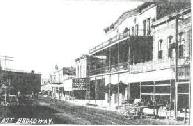 15.
Continue
on down to 205 Fisk, to what is now Julie A. Taylor,
CPA's office. The B. S. "Steve" Boysen family who
came over from Denmark built this two-story building in
1880. They opened the Boysen Meat Market on the
first floor and the family lived on the second
floor. There was an ad in the 1913 telephone book
that stated "Choice meats of all kinds, fish and oysters
in season." Boysen owned a large pasture near town
and his pens were always filled with "beeves, hogs and
sheep" for his customer's needs! The Boysen Market
was still in business in 1930. 15.
Continue
on down to 205 Fisk, to what is now Julie A. Taylor,
CPA's office. The B. S. "Steve" Boysen family who
came over from Denmark built this two-story building in
1880. They opened the Boysen Meat Market on the
first floor and the family lived on the second
floor. There was an ad in the 1913 telephone book
that stated "Choice meats of all kinds, fish and oysters
in season." Boysen owned a large pasture near town
and his pens were always filled with "beeves, hogs and
sheep" for his customer's needs! The Boysen Market
was still in business in 1930.
You will find in the sidewalk, on the left side of this
building, the name of A. Arczie. He was a concrete
man who built most of the sidewalks in this old part of
Brownwood. He was part of the Joseph Krischke & Son
Contractors and Builders of that day. These
sidewalks were poured in the early 1900's, prior to
1910. Arczie's two story stone home, which is still
standing, is located on Pecos Street over behind the
coliseum. You will find that name again in the sidewalk
next to the old Brooke Smith and Company Bank building
at 114 E. Baker.
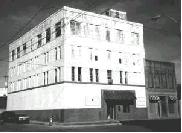 16. Next
door to Julie Taylor's office, at 201 N. Fisk, W. D. R.
McConnell, a dry good merchant, had a building here in a
wooden store constructed of rawhide lumber, that is,
green lumber. This lot was later to become the
site of the Crown Hotel from 1904 to 1919. The
Graham Hotel took over the hotel, from 1919 to 1932.
When the Graham Hotel took over it only had three
stories. If you will look up, you will
notice that a fourth floor was added. This was
done in 1920. The hotel was owned by William
Graham. The Brownwood Rotary Club was organized in 1920
and first met in this hotel. 16. Next
door to Julie Taylor's office, at 201 N. Fisk, W. D. R.
McConnell, a dry good merchant, had a building here in a
wooden store constructed of rawhide lumber, that is,
green lumber. This lot was later to become the
site of the Crown Hotel from 1904 to 1919. The
Graham Hotel took over the hotel, from 1919 to 1932.
When the Graham Hotel took over it only had three
stories. If you will look up, you will
notice that a fourth floor was added. This was
done in 1920. The hotel was owned by William
Graham. The Brownwood Rotary Club was organized in 1920
and first met in this hotel.
At the beginning of World War II and the building of
Camp Bowie, the old hotel was remodeled and was used by
the Salvation Army USA for a USO Club until the war was
over. During the late 1940's and early 1950's the
Chamber of Commerce office were in the building as well
as the Soil Conservation Service. A clothing center was
located on the third floor and the Jaycees had a boys
club on the fourth floor. They had a boxing ring
and a boxing club. Ed Devenry had boxing matches
up on the fourth floor.
In the late 50's the building was sold to the
VFW. They had bingo on the second floor and had
their meetings on the first floor. The Eagles Club
also met on the second floor.
Insurance Specialists have occupied the building since
1988. Prior to that time, Landmark Life was in the
building when Putter Jarvis bought the building,
remodeled it, and moved in February 1968.
100 Block N. Fisk
17. At the NE corner of the nex block, 117 N.
Fisk, on the Brown Street side, you will see in the
sidewalk the name of "O. C. Pouns, 1928." This was
when this sidewalk was built. He lived in the back
of this building for many years.
18. Look across the street. The building
now occupied by Porter Insurance Company formerly was
the Red Top Service Station from 1923 to 1938 and later
was a used car dealer. In back of the Porter
Insurance Company, in 1885, was the Sunny South Hotel.
100 Block Fisk
19. Continue down this West side of the street
until you come to the vacant lot on your right.
The first picture show that Nelse Allman saw was about
1899 in this area. It was on the back of the
northeast side of a building his father had built in
1886 at 101 Fisk. There were no seats; you simple stood
in the courtyard and watched the show. It was not
actually a motion picture, but it was a magic lantern
show, done with slides, though the operator was clever
in securing the effect of a moving train.
According to Allman, there were times when he made his
projection on the wall of the building too realistic for
the comfort of nearby watchers. The show was free,
sponsored by merchants who bought advertising from the
magic lanterns owner. He eventually moved from
there to the middle of the block, on what is now the
North Fisk side, and opened an indoor theater.
20. Now look across the street to the two-story
building just south of Porter Insurance. This
building, which is on the NE corner of Fisk and Baker,
was built in 1888 and was originally the Hurlbut
Hardware Company. They had five warehouses and
carried harvesters, gins, rotary plows, planters,
carriages, buggies, bicycles, steel ranges,
refrigerators, Red Jack pumps, saddles, harnesses, ten
and sheet metal roofing. The year they opened this
store, they hired Lee Watson as their bookkeeper.
In 1893, Lee Watson married J. C. Weakley's daughter,
Mary Helen Weakley. Remember that J. C. Weakley
had a hardware store on South Broadway, across the
street from the courthouse, in 1876. Since then,
J. C. Weakley had moved his store several times and in
1893 he was located over where the Brownwood Hotel
Coffee Shop use to be. Well, Weakley offered his
new son-in-law a partnership in Weakley's hardware
store. He accepted and the now Weakley-Watson
store moved into this building in at 100 Fisk in
1909. They had their hardware store there until
1986 when they moved to their present location about a
block from here. The ceilings in this building are 16
feet high. They had a rolling ladder to retrieve
items from shelves, which went all the way to the
ceiling.
A buggy room occupied the entire second floor of this
building in the 1910's. They had double doors
located in the rear of the building for rolling the
buggies to the ground level on a ramp. The doors
are still there. They went out of the buggy
business in 1928 when they sold the last of their
buggies to a firm in San Saba for $25 each. The
front of the store was changed to its present appearance
in 1946. Weakley-Watson Hardware store is the
oldest continuous business in Brownwood, dating back to
that first store in 1876.
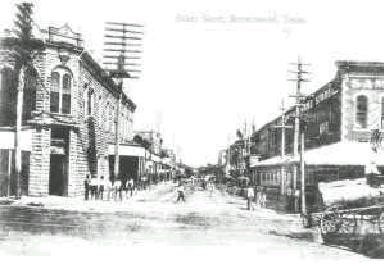 21. On the
right side of Baker Street was the Hemphill-Fain
Company, 101-105 N Fisk, located here in 1921, where the
Texas Furniture Company use to be. This building
has a history of its own. The second floor use to
serve as rooms for the hotel that was located next to
it, and it also served as the Elk's Lodge Hall in
1915. Texas Furniture was located in this building
from 1938 until 2001 when they moved to Commerce
Square. The building on the left side of the photo
burned and has been replaced with a building that looks
similar. 21. On the
right side of Baker Street was the Hemphill-Fain
Company, 101-105 N Fisk, located here in 1921, where the
Texas Furniture Company use to be. This building
has a history of its own. The second floor use to
serve as rooms for the hotel that was located next to
it, and it also served as the Elk's Lodge Hall in
1915. Texas Furniture was located in this building
from 1938 until 2001 when they moved to Commerce
Square. The building on the left side of the photo
burned and has been replaced with a building that looks
similar.
By the way, Fisk Street, use to be named Church Street
because of all the churches that were located on this
street, South of where we are standing. About
1909, the name was changed to Fisk Street.
East Baker
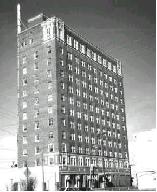 22.
Now
walk to the corner of Fisk and Baker and look across the
street to the tall twelve-story building there. In
the late 20's there existed a need for a new hotel in
Brownwood. The two main hotels, the Graham on Fisk
and the Southern Hotel on Center had both deteriorated
to the point where they were not suited to house the
traveling public. Joe Renfro, who owned several
drug stores in town, spearheaded the building of a new
hotel to be known as the Hotel Brownwood. The
twelve-story building cost $600,000 and work started on
the building on January 1, 1930, and was completed that
November. The hotel was very successful during
World War II with contractors for Camp Bowie and the
families of Camp Bowie soldiers staying at the
hotel. All the service clubs were now meeting at
the hotel and many a dinner and event was held in the
ballroom on the top floor. The swimming pool, now
filled with dirt, was built in 1964, and the hotel
became known as the Browntowner Hotel. 22.
Now
walk to the corner of Fisk and Baker and look across the
street to the tall twelve-story building there. In
the late 20's there existed a need for a new hotel in
Brownwood. The two main hotels, the Graham on Fisk
and the Southern Hotel on Center had both deteriorated
to the point where they were not suited to house the
traveling public. Joe Renfro, who owned several
drug stores in town, spearheaded the building of a new
hotel to be known as the Hotel Brownwood. The
twelve-story building cost $600,000 and work started on
the building on January 1, 1930, and was completed that
November. The hotel was very successful during
World War II with contractors for Camp Bowie and the
families of Camp Bowie soldiers staying at the
hotel. All the service clubs were now meeting at
the hotel and many a dinner and event was held in the
ballroom on the top floor. The swimming pool, now
filled with dirt, was built in 1964, and the hotel
became known as the Browntowner Hotel.
The hotel declined over the years and on February 19,
1969, Howard Payne announced that as of March 10, the
building would become the Sid Richardson dormitory for
men. The hotel is now closed and the owner of the
building has been looking for a buyer for several years.
23. Turn the corner and go to your right and go
west on Baker Street. Behind the Texas Furniture
store, on Baker Street, is the George & Ingram
Barber Shop. There has been a barbershop in this
building since 1893. It still has baths in the
back of the shop.
24. Next door, what is now a parking lot was the
Maxwell Hotel (1888). The name of this hotel
changed many times. It was also the Walker
Hotel (1893); the Crown Hotel (1904 - 1920), the
Princess Hotel (1913 - 1915); the Jefferson Hotel
(1921-1925); the Texas Hotel (1927-29) and finally the
Travelers Hotel from 1944 - 1947, all located at 200-220
E. Baker. The building was finally torn down in
1954 and the land made into a parking lot.
Interesting, the first water closets in Brownwood were
located in the Maxwell Hotel. One was for women
and one was for men. They were the type with the tank
overhead and a pull chain. It scared many people
when they pulled the chain and all that water came
rushing down to flush the toilet!
25. Across the street you will see the Winn
Pharmacy at 203 E. Baker. In 1913 this was the
Hallum-Langtry Drug Company and in 1925 became the
Hallum Drug Company.
26. Next to the pharmacy, at 201 E. Baker, was
the Renfro-McMinn Drug, in 1925. This building was
built by John Greenleaf Fisk in 1893. It has served as a
drugstore, grocery store, paint store and is now a CPA
office. Henry Colyer's CPA offices have occupied
this building since 1956.
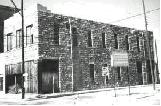 27.
The
vacant, boarded up two story building, just at the end
of this parking lot and across Brown Street, at 114 E.
Baker, was a private bank called the Pecan Valley
Bank. This bank was formerly located on the
SW corner of the Square in 1876. Later the bank
changed its name to the Brooke Smith and Company and
relocated here. There were no such things as
examiners for a private bank and when the depression
came after World War I, Mr. Smith was unable to collect
his loans and just closed the doors to the bank in
1921. He called a meeting of his depositors at the
Lyric Theater and told him of his decision. He
owned a lot of land in Brownwood and exchanged the land
for their deposits so there were very few big
losses. The K of P Lodge was located on the second
floor of the bank in 1898 and was still there in the
1960's. 27.
The
vacant, boarded up two story building, just at the end
of this parking lot and across Brown Street, at 114 E.
Baker, was a private bank called the Pecan Valley
Bank. This bank was formerly located on the
SW corner of the Square in 1876. Later the bank
changed its name to the Brooke Smith and Company and
relocated here. There were no such things as
examiners for a private bank and when the depression
came after World War I, Mr. Smith was unable to collect
his loans and just closed the doors to the bank in
1921. He called a meeting of his depositors at the
Lyric Theater and told him of his decision. He
owned a lot of land in Brownwood and exchanged the land
for their deposits so there were very few big
losses. The K of P Lodge was located on the second
floor of the bank in 1898 and was still there in the
1960's.
If you will look at the sidewalk on the east side of
this bank building, you will notice that the name of A.
Arczie is stamped in the concrete of the sidewalk.
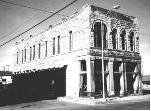 28.
Now
look directly across the street at 115 E. Baker at a
building that is being restored. This was the
Coggin National Bank, which was established in 1883 as
the Coggin Bros. & Ford Bank. This bank was
forced to close in 1930 and was taken over by the
Citizen National Bank. 28.
Now
look directly across the street at 115 E. Baker at a
building that is being restored. This was the
Coggin National Bank, which was established in 1883 as
the Coggin Bros. & Ford Bank. This bank was
forced to close in 1930 and was taken over by the
Citizen National Bank.
Next door to this bank, now a vacant lot, was a theater
built by Claude Boyette. Nothing is known about
this theater except that it was there from 1915 to at
least 1920. Claude Boyette also built the Gem
Theater at 203 Center around 1928.
Corner of Baker & Center
29. If you will look further down this empty lot,
which is being turned into a park, was the J. C. Penny
Company. It was located there at the SE corner of
Center and Baker from 1950 to 1980 when it moved out to
Heartland Mall in Early. Prior to this time, the
Garner-Alvis Company Department Store was located here
from about 1925 till 1947.
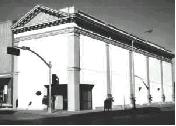 30. Now walk down to
the corner of Baker and Center Streets. Look
diagonally across the street at the two-story building
there on the corner. On June 29, 1906, a group in
town founded the Citizens National Bank. They were
located here at 201 Center Ave, now owned by Krischke
& Co, PC. The bank building was built at that
corner in 1909 and served as a bank until
1928. In 1928, the bank built a new
six-story building at 300 Center (now Brownwood
Manor). It is the tall building you see in the
next block down Center and on your left. A J. F. Renfro
Drug then moved into this old bank building and was
located here from 1931 to 1969. Krischke & Co,
PC has owned the building since 1981. 30. Now walk down to
the corner of Baker and Center Streets. Look
diagonally across the street at the two-story building
there on the corner. On June 29, 1906, a group in
town founded the Citizens National Bank. They were
located here at 201 Center Ave, now owned by Krischke
& Co, PC. The bank building was built at that
corner in 1909 and served as a bank until
1928. In 1928, the bank built a new
six-story building at 300 Center (now Brownwood
Manor). It is the tall building you see in the
next block down Center and on your left. A J. F. Renfro
Drug then moved into this old bank building and was
located here from 1931 to 1969. Krischke & Co,
PC has owned the building since 1981.
31. Here at this NE corner of Baker and Center
where you are standing, was an Opera House located in
the second floor of the then Bernet Building. It
was a two story stone building about fifty feet
wide. The Brownwood National Bank later took over
this corner and built this five-story bank building
there in 1910. This was the first tall building in
the city and had the first elevator and indoor
toilets. The bank later became the First National
Bank at Brownwood in 1921. On July 30, 1960, the
bank moved across the street to what is now known as
Bank of America. The Greenwood Printing Company
was located next to the bank in 1913, where the vacant
lot is now.
32. Across the street, on the corner, where Bank
of America is now located, the J.C. Penny Company had a
store from 1923 to 1958. They, of course, built
their new store and moved diagonally across the street
over to where the benches are now. The Ritz Theater was
located two doors down from Penny's at 103 Center from
1941 - 1949. It shut down after World War II and
Camp Bowie closed. The F. W. Woolworth store was
located on that side of the street at 105-109 Center
from 1923 to 1952.
100 Block of Center
33. Now let's continue walking back toward the
courthouse on this side of Center Street. Stop at
this next corner, where the Southwest Appliance and
Furniture store is now.
In about 1884, the First National Bank of Brownwood was
established and was originally located on the NW corner
of Center and S. Broadway, the same location as the
Pecan Valley Bank in 1876. The bank moved sometime
later to this SE corner of 100 Center and Mayes. The
building is no longer here. On July 1, 1898, it
surrendered its charter and continued as a private bank
as The Trent Bank. D. W. Trent of Galveston owned
the bank. There is no record of the date of its
closing. Also at this corner was the Southern
Savings and Loan Association. Later, the Baxter
Brothers Department Store was located here in 1913 and
the Brownwood Semi-Weekly News was here from 1921 to
1923.
The Brownwood Banner, and H. G. Seaman and one of
Weakley's Hardware stores was at 100-2 N. Center.
100 Block of N. Center
 34.
Look
across the street toward the courthouse at the two story
building in this next block. The Brownwood
National Bank was founded in 1892 and was located at
this NE corner, here at 100 N. Center just across the
street from the First National Bank of Brownwood (which
was located at 100 Center). This bank moved in 1910 to
its new five-story building down the street where we
just came from, and later became the First National Bank
at Brownwood. Later, in this old building, the
Queen Hotel was in existence from 1921 to 1930. 34.
Look
across the street toward the courthouse at the two story
building in this next block. The Brownwood
National Bank was founded in 1892 and was located at
this NE corner, here at 100 N. Center just across the
street from the First National Bank of Brownwood (which
was located at 100 Center). This bank moved in 1910 to
its new five-story building down the street where we
just came from, and later became the First National Bank
at Brownwood. Later, in this old building, the
Queen Hotel was in existence from 1921 to 1930.
It is here that the street changes from Center to North
Center.
35. At the other end of this same building, what
is now Brownwood Southwest Appliance, the Kentucky Store
of Ramey, Smith & Company was located.
Southwest Appliances has been located in this area since
about 1966. This building has very thick walls
that divide the five buildings that make up this
block. Note that all the windows on the second
floor are rounded at the top except for the windows on
the north end of the building where they are
square. That is because that section of the
building was added on later.
In 1940, Dudley Brothers Federal Tires and Tubes was
also on the north corner of this building, next to it
was Central Hardware Co., and then the Texas Cafe was
where the Brownwood Bank was located. On the
backside of the building, in 1940, was a cleaners, a
tailor shop and a rubber welding shop. On the second
floor of this building, above where the Texas Cafe was,
is a large canvas painting on a wall of Antelope.
The mural was thought to have been painted by World War
II prisoners that were being held at Camp Bowie.
200 Block of N. Center
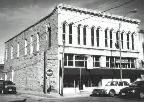 36.
Directly
across the street from the Texas Cafe, 201 N. Center, in
1895, Wise & Mayes had a bookstore known locally as
the "post office bookstore." The post office was
located in the back of the store and was run by E. E.
King, a democrat and Monk Mullins, a republican.
They alternated as postmaster, and assistant postmaster,
depending on which party was in the White House at the
time. 36.
Directly
across the street from the Texas Cafe, 201 N. Center, in
1895, Wise & Mayes had a bookstore known locally as
the "post office bookstore." The post office was
located in the back of the store and was run by E. E.
King, a democrat and Monk Mullins, a republican.
They alternated as postmaster, and assistant postmaster,
depending on which party was in the White House at the
time.
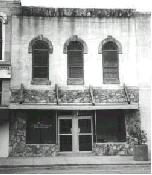 37.
At
205 N. Center was located the Texas Theater, which was
active from 1941 to 1949. Some of the projection
equipment is still located in the building. 37.
At
205 N. Center was located the Texas Theater, which was
active from 1941 to 1949. Some of the projection
equipment is still located in the building.
Now, continue walking on down N. Center toward the
Courthouse to the end of the next block and cross the
street to the West Side.
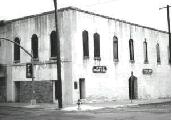 38.
You
will find the old Coggin and Parks Building located here
on the SW corner of N. Center and Broadway.
William W. Bell Law officers now occupy this
building. There is a historical plaque located on
the corner of the building on the S. Broadway side of
Center Street. The historical plaque, dated 1981 reads,
"Brothers Samuel R. Coggin (1831- 1915) and Moses J.
'Mody' Coggin (1824-1902) prominent area ranchers,
business leders, and philanthropists, in partnership
with the businessman William Claibourne 'Clay' Parks
(1833-1916) completed this two-story commercial building
in 1876. Originally part of a larger structure, it
housed a variety of businesses, including a grocery,
hardware store, business college and restaurant.
Because of the primary location, the Coggins-Parks
building figured prominently in the early history of
Brownwood. The exterior of the structure as later
altered substantially." At one time there was an
Opera House located on the second story of this
building. There was a Wilson Grocery here in 1913. 38.
You
will find the old Coggin and Parks Building located here
on the SW corner of N. Center and Broadway.
William W. Bell Law officers now occupy this
building. There is a historical plaque located on
the corner of the building on the S. Broadway side of
Center Street. The historical plaque, dated 1981 reads,
"Brothers Samuel R. Coggin (1831- 1915) and Moses J.
'Mody' Coggin (1824-1902) prominent area ranchers,
business leders, and philanthropists, in partnership
with the businessman William Claibourne 'Clay' Parks
(1833-1916) completed this two-story commercial building
in 1876. Originally part of a larger structure, it
housed a variety of businesses, including a grocery,
hardware store, business college and restaurant.
Because of the primary location, the Coggins-Parks
building figured prominently in the early history of
Brownwood. The exterior of the structure as later
altered substantially." At one time there was an
Opera House located on the second story of this
building. There was a Wilson Grocery here in 1913.
West of Courthouse Square
39. Look down South Broadway to the left.
The two story structure located at 108 S. Broadway was
the site of many different hotels dating back to 1885.
The Harper Hotel and Grocery Store, known as the "The
Harper House" occupied the site from around
1904-1942. At the top of the structure is a marker
with a backward "S" in the word “House". Stories
say that George Harper, had a little too much “spirit",
when molding the marker and it has been there ever
since. The hotel had about 30 rooms with the City
Wagon Yard located behind it. The dining room served
family-styled meals for 25 cents. The present
owners, direct descendants of the Harper family are
restoring the structure and creating two loft apartments
where the hotel rooms once were.
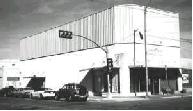 40.
Cross
the street going toward the museum and stop on the
corner. You are on the sidewalk directly across
from the courthouse now. We had on this corner, in
1876, the Smith & Steffens Dry Goods and Groceries
establishment. The Pecan Valley Bank was located in the
back of the store. By 1884, the Pecan Valley Bank had
moved. The name of yet another new bank appeared
on the sign on the same corner as the First National
Bank. Brooke Smith had his band in the rear of
this store. Their best customers were the cowboys and
ranchers that came to town to shop and drink. 40.
Cross
the street going toward the museum and stop on the
corner. You are on the sidewalk directly across
from the courthouse now. We had on this corner, in
1876, the Smith & Steffens Dry Goods and Groceries
establishment. The Pecan Valley Bank was located in the
back of the store. By 1884, the Pecan Valley Bank had
moved. The name of yet another new bank appeared
on the sign on the same corner as the First National
Bank. Brooke Smith had his band in the rear of
this store. Their best customers were the cowboys and
ranchers that came to town to shop and drink.
We know that further down this block was a bakery &
confectionery, a furniture and coffin store and a drug
store on the corner. There was also N. A. Allman
& Brother and Wally Bell's place and The Crystal
Saloon. Other places of business that were located
in this block included Ed Parks furniture store, and Dr.
Johnson's drug store. You will want to continue walking
on north side of this street until you get back to the
museum.
Back at Museum
41. Before the country jail was built, there
stood the ruins of an old grain elevator destroyed by
fire, and later rebuilt. Behind it was the Brownwood
Bottling Company.
We hope you have enjoyed this brief walking tour of
this old historical section of Brownwood. We are
indebted to many resources for the writing of this
tour. This includes the Brownwood Bulletin, April
5, 1984; Pecan Valley Days, by T. C. Smith, Jr., 1956,
written on the 100th Anniversary of Brownwood; Something
About Brown, by T. R. Havins; The Nice and Nasty in
Brown County by Ruth Griffin Spence, 1988; the many
writings of Lee Watson; the Sanborn Fire Insurance maps,
1885-1946; Pattie Jordan's 4th Grade Class at Woodland
Heights Elementary School; the various City Directories
in the Brownwood Library and all of the citizens of
Brownwood who shared their personal information and
photos for this tour.
.
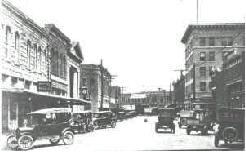
Click HERE to
download the map that goes with this walking tour.
Last Changed: March 24, 2011
Return to top
Return to Museum
Home Page
Return to Brown
County History Home Page |